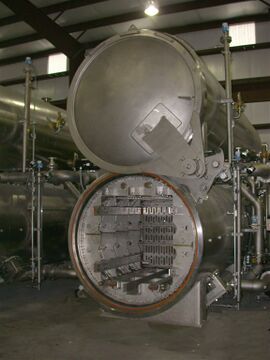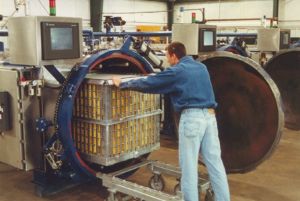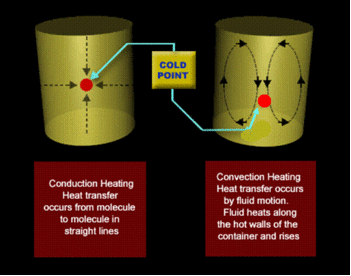Course:FNH200/Lessons/Lesson 06/Page 06.5
6.5 Heat Transfer Characteristics of Foods
The rate and mechanism by which heat is transferred through a food material during thermal processing is very important in determining how long it will take the slowest heating part of the food (the cold point) to reach the desired time-temperature combination required to ensure destruction of Clostridium botulinum spores with an adequate margin of safety.
Factors that affect the heat transfer characteristics of a food are
- the consistency of the food (liquid -viscous or non viscous- or solid)
- the chemical composition of the food.
- other factors that are important are the container size, shape and composition.
Foods that are thermally processed after being packed in containers (such as metal cans, glass bottles, plastic pouches) are exposed to an environment of pressurized steam within a vessel called a retort (Figure 6.3).
A retort operates very much on the same principles as the pressure cooker or pressure canner with which you may be more familiar. Packages of foods are placed in the retort after which the retort is sealed and the air within is vented by purging the retort with steam. Once the retort is properly vented, the steam pressure inside is increased to achieve the desired processing temperature.
A processing temperature of 250°F (121°C) is achieved by establishing a steam pressure of 15 pounds per square inch within the retort. In comparison, the normal household pressure cooker and pressure canner operate at 10 pounds per square inch steam pressure (116°C or 214°F). The containers of food in the retort are bathed in an atmosphere of hot, high pressure steam. Heat is transferred by the hot steam condensing on the containers of food with the heat transferred through the walls of the containers (glass, metal or plastic) to the food inside the container. If the food is a solid (salmon, for example), heat energy is transferred by conduction (Figure 6.4).
Heating food by conduction is a slow process. The cold point (illustrated in Figure 6.4) is in the centre of the container if the container is cylindrical (e.g., canned salmon). Foods that are non-viscous liquids (canned evaporated milk, for example) heat by convection.
Foods that are a combination of solids and liquid components heat up by a combination of convection and conduction heating. Note the location of the cold points in relation to conduction heating (in the geometric centre of a cylindrical container) and convection heating (one third of the way up the centre axis measured from the bottom of the cylindrical container). The actual cold point need to be determined by extensive heat penetration studies using insertion of thermocouples inside the can and collecting the heating data throughout the process. The cold point of a container of food must receive the required amount of thermal energy to ensure killing of Clostridium botulinum spores that may be present and to ensure a sufficient margin of safety.
If a food formulation is changed such that the mechanism of heat transfer is altered from convection heating to conduction heating, the processing times should be altered to accommodate the change in mechanism of heat transfer, otherwise the food could be under processed and could pose a potential health hazard with respect to botulism. In the past, outbreaks of botulism have occurred due to such changes in heat transfer resulting from changes in product formulation or in the changes in product piece size which can affect the rate of heat transfer.
| Want to learn more? |
|


